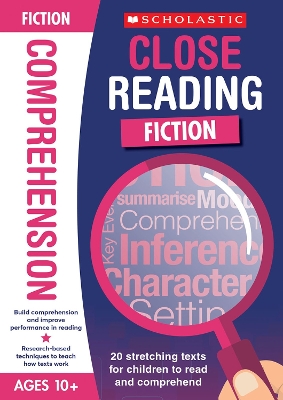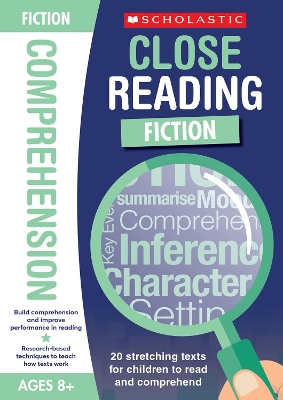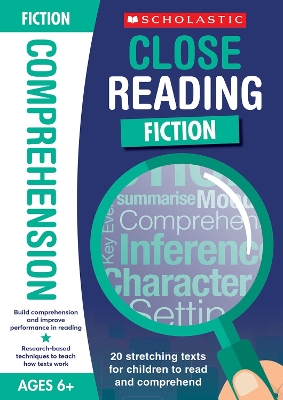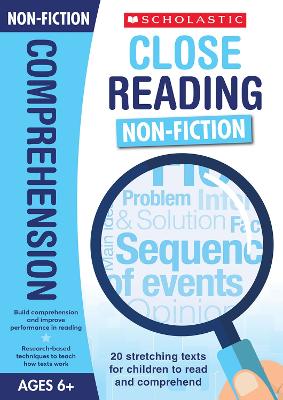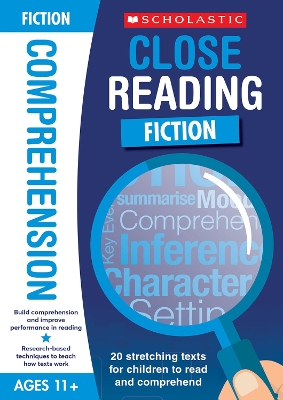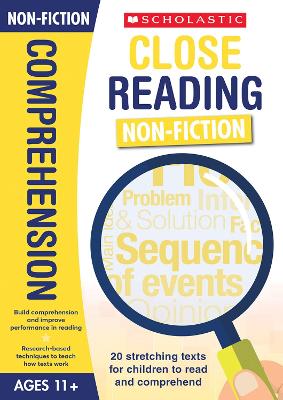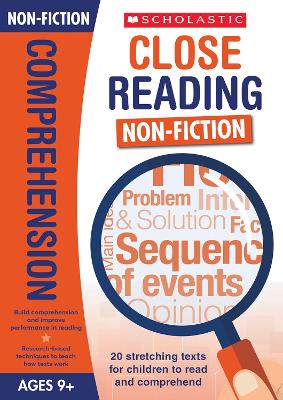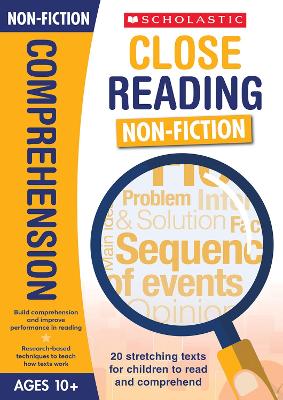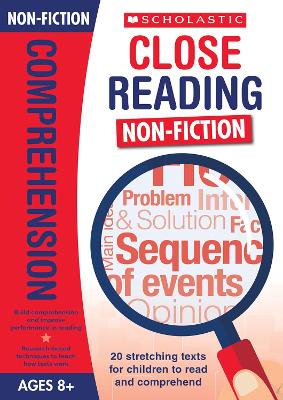Close Reading
12 total works
short texts suitable for ages 6 to 11+. Each Teacher's book includes
a comprehensive introduction along with Lexile levelled photocopiable
texts with accompanying questions that use close reading
comprehension strategies.
Close reading involves careful study of a short text passage to build
a deep, critical understanding of the text. By developing children's
comprehension and higher-order thinking skills, you can
help them make sense of the world.
The Comprehension areas focused on include for the fiction titles:
Character, Point of View, Setting/Mood, Key Events and Details,
Sequence of events, Conflict & resolution, Context clues, Compare
& contrast, Making inferences and Summarising.
And for the non-fiction titles comprehension areas include: Main
idea & details, Sequence of events, Fact & opinion, Compare & contrast,
Cause and effect, Context clues, Problem & solution and summarising.
short texts suitable for ages 6 to 11+. Each Teacher's book includes
a comprehensive introduction along with Lexile levelled photocopiable
texts with accompanying questions that use close reading
comprehension strategies.
Close reading involves careful study of a short text passage to build
a deep, critical understanding of the text. By developing children's
comprehension and higher-order thinking skills, you can
help them make sense of the world.
The Comprehension areas focused on include for the fiction titles:
Character, Point of View, Setting/Mood, Key Events and Details,
Sequence of events, Conflict & resolution, Context clues, Compare
& contrast, Making inferences and Summarising.
And for the non-fiction titles comprehension areas include: Main
idea & details, Sequence of events, Fact & opinion, Compare & contrast,
Cause and effect, Context clues, Problem & solution and summarising.
short texts suitable for ages 6 to 11+. Each Teacher's book includes
a comprehensive introduction along with Lexile levelled photocopiable
texts with accompanying questions that use close reading
comprehension strategies.
Close reading involves careful study of a short text passage to build
a deep, critical understanding of the text. By developing children's
comprehension and higher-order thinking skills, you can
help them make sense of the world.
The Comprehension areas focused on include for the fiction titles:
Character, Point of View, Setting/Mood, Key Events and Details,
Sequence of events, Conflict & resolution, Context clues, Compare
& contrast, Making inferences and Summarising.
And for the non-fiction titles comprehension areas include: Main
idea & details, Sequence of events, Fact & opinion, Compare & contrast,
Cause and effect, Context clues, Problem & solution and summarising.
short texts suitable for ages 6 to 11+. Each Teacher's book includes
a comprehensive introduction along with Lexile levelled photocopiable
texts with accompanying questions that use close reading
comprehension strategies.
Close reading involves careful study of a short text passage to build
a deep, critical understanding of the text. By developing children's
comprehension and higher-order thinking skills, you can
help them make sense of the world.
The Comprehension areas focused on include for the fiction titles:
Character, Point of View, Setting/Mood, Key Events and Details,
Sequence of events, Conflict & resolution, Context clues, Compare
& contrast, Making inferences and Summarising.
And for the non-fiction titles comprehension areas include: Main
idea & details, Sequence of events, Fact & opinion, Compare & contrast,
Cause and effect, Context clues, Problem & solution and summarising.
short texts suitable for ages 6 to 11+. Each Teacher's book includes
a comprehensive introduction along with Lexile levelled photocopiable
texts with accompanying questions that use close reading
comprehension strategies.
Close reading involves careful study of a short text passage to build
a deep, critical understanding of the text. By developing children's
comprehension and higher-order thinking skills, you can
help them make sense of the world.
The Comprehension areas focused on include for the fiction titles:
Character, Point of View, Setting/Mood, Key Events and Details,
Sequence of events, Conflict & resolution, Context clues, Compare
& contrast, Making inferences and Summarising.
And for the non-fiction titles comprehension areas include: Main
idea & details, Sequence of events, Fact & opinion, Compare & contrast,
Cause and effect, Context clues, Problem & solution and summarising.
short texts suitable for ages 6 to 11+. Each Teacher's book includes
a comprehensive introduction along with Lexile levelled photocopiable
texts with accompanying questions that use close reading
comprehension strategies.
Close reading involves careful study of a short text passage to build
a deep, critical understanding of the text. By developing children's
comprehension and higher-order thinking skills, you can
help them make sense of the world.
The Comprehension areas focused on include for the fiction titles:
Character, Point of View, Setting/Mood, Key Events and Details,
Sequence of events, Conflict & resolution, Context clues, Compare
& contrast, Making inferences and Summarising.
And for the non-fiction titles comprehension areas include: Main
idea & details, Sequence of events, Fact & opinion, Compare & contrast,
Cause and effect, Context clues, Problem & solution and summarising.
short texts suitable for ages 6 to 11+. Each Teacher's book includes
a comprehensive introduction along with Lexile levelled photocopiable
texts with accompanying questions that use close reading
comprehension strategies.
Close reading involves careful study of a short text passage to build
a deep, critical understanding of the text. By developing children's
comprehension and higher-order thinking skills, you can
help them make sense of the world.
The Comprehension areas focused on include for the fiction titles:
Character, Point of View, Setting/Mood, Key Events and Details,
Sequence of events, Conflict & resolution, Context clues, Compare
& contrast, Making inferences and Summarising.
And for the non-fiction titles comprehension areas include: Main
idea & details, Sequence of events, Fact & opinion, Compare & contrast,
Cause and effect, Context clues, Problem & solution and summarising.
short texts suitable for ages 6 to 11+. Each Teacher's book includes
a comprehensive introduction along with Lexile levelled photocopiable
texts with accompanying questions that use close reading
comprehension strategies.
Close reading involves careful study of a short text passage to build
a deep, critical understanding of the text. By developing children's
comprehension and higher-order thinking skills, you can
help them make sense of the world.
The Comprehension areas focused on include for the fiction titles:
Character, Point of View, Setting/Mood, Key Events and Details,
Sequence of events, Conflict & resolution, Context clues, Compare
& contrast, Making inferences and Summarising.
And for the non-fiction titles comprehension areas include: Main
idea & details, Sequence of events, Fact & opinion, Compare & contrast,
Cause and effect, Context clues, Problem & solution and summarising.
short texts suitable for ages 6 to 11+. Each Teacher's book includes
a comprehensive introduction along with Lexile levelled photocopiable
texts with accompanying questions that use close reading
comprehension strategies.
Close reading involves careful study of a short text passage to build
a deep, critical understanding of the text. By developing children's
comprehension and higher-order thinking skills, you can
help them make sense of the world.
The Comprehension areas focused on include for the fiction titles:
Character, Point of View, Setting/Mood, Key Events and Details,
Sequence of events, Conflict & resolution, Context clues, Compare
& contrast, Making inferences and Summarising.
And for the non-fiction titles comprehension areas include: Main
idea & details, Sequence of events, Fact & opinion, Compare & contrast,
Cause and effect, Context clues, Problem & solution and summarising.
short texts suitable for ages 6 to 11+. Each Teacher's book includes
a comprehensive introduction along with Lexile levelled photocopiable
texts with accompanying questions that use close reading
comprehension strategies.
Close reading involves careful study of a short text passage to build
a deep, critical understanding of the text. By developing children's
comprehension and higher-order thinking skills, you can
help them make sense of the world.
The Comprehension areas focused on include for the fiction titles:
Character, Point of View, Setting/Mood, Key Events and Details,
Sequence of events, Conflict & resolution, Context clues, Compare
& contrast, Making inferences and Summarising.
And for the non-fiction titles comprehension areas include: Main
idea & details, Sequence of events, Fact & opinion, Compare & contrast,
Cause and effect, Context clues, Problem & solution and summarising.
short texts suitable for ages 6 to 11+. Each Teacher's book includes
a comprehensive introduction along with Lexile levelled photocopiable
texts with accompanying questions that use close reading
comprehension strategies.
Close reading involves careful study of a short text passage to build
a deep, critical understanding of the text. By developing children's
comprehension and higher-order thinking skills, you can
help them make sense of the world.
The Comprehension areas focused on include for the fiction titles:
Character, Point of View, Setting/Mood, Key Events and Details,
Sequence of events, Conflict & resolution, Context clues, Compare
& contrast, Making inferences and Summarising.
And for the non-fiction titles comprehension areas include: Main
idea & details, Sequence of events, Fact & opinion, Compare & contrast,
Cause and effect, Context clues, Problem & solution and summarising.
short texts suitable for ages 6 to 11+. Each Teacher's book includes
a comprehensive introduction along with Lexile levelled photocopiable
texts with accompanying questions that use close reading
comprehension strategies.
Close reading involves careful study of a short text passage to build
a deep, critical understanding of the text. By developing children's
comprehension and higher-order thinking skills, you can
help them make sense of the world.
The Comprehension areas focused on include for the fiction titles:
Character, Point of View, Setting/Mood, Key Events and Details,
Sequence of events, Conflict & resolution, Context clues, Compare
& contrast, Making inferences and Summarising.
And for the non-fiction titles comprehension areas include: Main
idea & details, Sequence of events, Fact & opinion, Compare & contrast,
Cause and effect, Context clues, Problem & solution and summarising.
